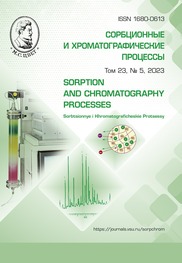Influence of the structure of quinoline derivatives on their sorption on hypercrosslinked polystyrene
Abstract
The article is devoted to the study of the chromatographic behaviour of quinoline and tetrahydroquinoline derivatives. The purpose of the study was to investigate the patterns of sorption of these compounds from aqueous-acetonitrile solutions on hyper-cross-linked polystyrene using reverse-phase high-performance liquid chromatography. The volume, polarizability, lipophilicity, and dipole moment of molecules of quinoline derivatives were calculated, which significantly depended on the nature and position of functional groups and substituents in the main nucleus. It has been established that the appearance of functional groups and substituents leads to an increase in the volume and polarizability of the molecules of quinoline derivatives compared to unsubstituted quinoline and methylquinoline, while the lipophilicity and dipole moment change depending on the nature of the substituent and its position in the main fragment. The dependences of sorption characteristics on the structure and physicochemical properties of sorbates were obtained. It has been shown that, in accordance with the laws of the reversed-phase version of liquid chromatography, the retention of substances changes symbatically with the change in the characteristics of the molecules responsible for dispersion interactions. In this case, the presence in the molecules of halogen atoms, phenyl radicals and other substituents capable of π-interactions with the surface of hyper-cross-linked polystyrene led to a significant increase in retention, and the presence of a carboxyl group or carboxyalkyls prone to interaction with the polar eluent significantly weakens retention. The appearance of an ester group in sorbate molecules generally significantly increased the volume, polarizability and lipophilicity of the corresponding derivatives, but had virtually no effect on retention, and therefore it was suggested that the presence of a carbonyl oxygen atom, capable of interacting with the polar components of the eluent, neutralizes the effect of physical-chemical factors that determine the sorption of these substances due to dispersion interactions.
Thus, despite the symmetry in changes in the physicochemical parameters of the studied compounds and their retention, there was no strict proportionality, since, on the one hand, the retention of sorbates was carried out in accordance with the change in their physicochemical parameters, and on the other hand, it was determined by the tendency molecules of these compounds to competitive interactions with the components of the mobile phase.
The presented results of the study can be useful in the development and optimization of methods for analysing compounds with similar structures, as well as for developing the theory of sorption of polyfunctional compounds from multicomponent solutions and establishing the relationship between sorption characteristics, other physicochemical parameters and the structure of molecules.
Downloads
References
Anaya-Esparza L.M., de la Mora Z.V., Vázquez-Paulino O. et al., Bell Peppers (Capsicum annum L.) Losses and Wastes: Source for Food and Pharmaceutical Ap-plications. Molecules, 2021; 26: 5341. https://doi.org/10.3390/molecules26175341
Lemos V.C., Reimer J.J., Wormit A., Color for Life: Biosynthesis and Distribution of Phenolic Compounds in Pepper (Capsicum annuum). Agriculture, 2019; 9: 81. https://doi.org/10.3390/agriculture9040081
Lang Y.-Q., Yanagawa S., Sasanuma T. Orange Fruit Color in Capsicum due to Deletion of Capsanthin-capsorubin Synthe-sis Gene. Breeding Sci., 2004; 54: 33-39. https://doi.org/10.1270/jsbbs.54.33
Arimboor R., Natarajan R.B., Menon K.R., Red pepper (Capsicum annuum) ca-rotenoids as a source of natural food colors: analysis and stability – a review. J. Food Sci. Technol., 2015; 52: 1258-1271. https://doi.org/10.1007/s13197-014-1260-7
Hassan N.V., Yusof N.A., Yahaya A.E., Carotenoids of Capsicum Fruits: Pigment Profile and Health-Promoting Functional Attributes. Antioxidants, 2019; 8: 469. https://doi.org/10.3390/antiox8100469
Carpentier S., Knaus M., Suh M., As-sociations between Lutein, Zeaxanthin, and Age-Related Macular Degeneration: An Overview. Crit. Rev. Food Sci. Nutr. 2009; 49: 313-326. https://doi.org/10.1080/10408390802066979
Deineka V.I., Sorokopudov V.N., De-ineka L.A. Flowers of marigold (Tagetes) species as a source of xanthophylls. Pharm. Chem. J., 2007; 41: 540-542. https://doi.org/10.1007/s11094-008-0007-z
Deineka V.I., Sorokopudov V.N., De-ineka L.A. et al., Studies of Physalis alkekengi L. fruits as a source of xantho-phylls. Pharm. Chem. J., 2008; 42: 87-88. https://doi.org/10.1007/s11094-008-0065-2
Guzman I., Hamby S., Romero J. Var-iability of carotenoid biosynthesis in or-ange colored Capsicum spp. Plant Sci., 2010; 179: 49-59. https://doi.org/10.1016/j.plantsci.2010.04.014
Wall M.M., Waddell C.A., Bosland P.W. Variation in β-Carotene and Total Carotenoid Content in Fruits of Capsicum. Hort. Sci., 2001; 36: 746-749. https://doi.org/10.21273/HORTSCI.36.4.746
Sajilata M.G., Singhal R.S., Kama M.Y. The Carotenoid Pigment Zeaxan-thin—A Review. Compr. Rev. Food Sci. Food Safety, 2008; 7: 29-49. https://doi.org/10.1111/j.1541-4337.2007.00028.x
Zeb A., Murkovic M. Thin-layer chromatographic analysis of carotenoids in plant and animal samples J. Planar Chro-mat., 2000; 2: 94-103. https://doi.org/10.1556/JPC.23.2010.2.1
Bunea A., Socaciu C., Pintea A. Xanthophyll Esters in Fruits and Vegeta-bles. Not. Bot. Horti. Agrobo, 2014; 42: 310-324. https://doi.org/10.15835/nbha4229700
Wu L., Huang X., Shi K., Tan R. Bi-oavailability comparison of free and esteri-fied lutein for layer hens. Braz. J. Poultry Sci., 2009; 11: 95-98. https://doi.org/10.1590/S1516-635X2009000200004
Zenkevich I.G. Application of recur-rent relationships in chromatography, J. Chemometrics, 2009; 23: 179-187. https://doi.org/10.1002/cem.1214







